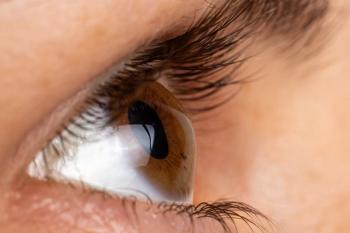
- November digital edition 2024
- Volume 16
- Issue 10
Wait, this is not allergies: Case report on carotid-cavernous fistula
Taking a thorough history and evaluating pertinent positives and negatives are always critical in diagnosing and treating these cases.
Although conjunctival redness and eyelid swelling can affect vision and comfort, they are also unsightly, giving the patient a sense of urgency to resolve the condition as soon as possible. As patients often do, I googled “swollen eyelid,” and the results list the common, possible causes such as allergies, blepharitis, styes, or pink eye (which is such a catch-all term). Recommended remedies include a cold compress or tea bag and lubricating eye drops, which should resolve the problem in a day.
Once it does not resolve or if there is any eye pain, these patients will present to your office. Eye pain is one of the leading causes of outpatient and emergency department visits.1
So, is it allergies, preseptal cellulitis, or something else? Taking a thorough history and evaluating pertinent positives and negatives are always critical in these cases. Let us examine a case study to understand better how to treat these patients.
Case report
A man aged 74 years presents to the emergency department stating that he is experiencing itching and irritation, which has been worsening over the past few weeks. He now has eye pain, eyelid swelling, and proptosis in the left eye. His recent history is a complicated spinal injection in which a vertebral body was injured. The patient has no reported vision changes in the left eye but has a dense cataract, so he states it may be hard to tell. However, he does have a history of uncomplicated cataract surgery in the right eye.
Upon examination, his visual acuity was 20/20 for his right eye and 20/200 for his left eye, with intraocular pressure (IOP) of 7/18. The left eye was dilated pharmaceutically from an outside provider, with no relative afferent pupillary defect by reserve. As for motility, the right eye was full, and the left eye had mild abduction restriction. Diplopia was noted in the left gaze. The right eye’s anterior segment presented within normal limits with a clear posterior chamber intraocular lens. For the left eye, mild proptosis was present with 2+ conjunctival/scleral injection with corkscrew vessels. The cornea was clear, with the anterior chamber quiet, a brunescent lens, and a poor view posteriorly (Figures 1, 2).The dilated fundus exam revealed a hazy view left eye with grossly normal disc and macula. Peripheral details were difficult to view. The right eye presented with normal cup-to-disc ratio, a flat macula, and no hole, tears, or detachments at 360 degrees. Findings from imaging from a CT brain and orbit with contract likely reflected a left carotid cavernous fistula (CCF). The imaging found a dilated and enhanced superior ophthalmic vein in the left eye (Figure 3). Asymmetric prominence of the left cavernous sinus and mild left proptosis were also present (Figure 4).
Assessment
The patient is presenting with subacute left eye swelling, redness, and ache. The examination shows mild proptosis and slight abduction and adduction deficits on the left. The findings are also concerning for an orbital process versus cavernous sinus pathology such as CCF. CT orbits showed an enlarged and enhanced left superior ophthalmic vein consistent with left CCF.
Plan
The next steps for this patient would be a neurosurgery consultation and management of CCF. Vascular imaging via CT angiography of the head and neck will also be needed. No acute intervention by ophthalmology will be required due to the IOP of the left eye, but the patient will need an ophthalmology clinic follow-up.
CCF overview
CCF is a pathological communication between the carotid arterial system and the cavernous sinus. This can have significant ophthalmic consequences, as evident in this case study. Given its potential to impact visual acuity and ocular health, a thorough understanding of CCF is essential. We will discuss etiology, clinical presentation, diagnostic methods, and management strategies for CCF.
Etiology and pathophysiology
CCFs can be classified based on their etiology into 2 primary types: traumatic and spontaneous. Traumatic CCFs often result from head injuries that disrupt the integrity of the cavernous sinus and adjacent carotid artery. Spontaneous CCFs, on the other hand, might be associated with underlying conditions such as connective tissue disorders, atherosclerosis, or hypertension.
The pathophysiology involves an abnormal connection between the high-pressure carotid artery and the low-pressure cavernous sinus (Figure 5). This shunting leads to increased venous pressure in the cavernous sinus, impairing the orbit’s venous drainage and causing ocular symptoms due to the congestion of the orbit.
Clinical presentation
Patients with CCF may present with various symptoms, often influenced by the type (high flow vs low flow) and size of the fistula. Common ophthalmic manifestations include the following2:
- Proptosis: Due to venous congestion
- Chemosis: Resulting from increased venous pressure
- Pulsatile exophthalmos: Where the eye visibly pulsates due to arterial blood flow
- Ocular bruit: Blood flow sounds coming from the eye, especially in high-flow fistulas
- Cranial nerve palsies: Particularly affecting the oculomotor, trochlear, and abducens nerves, leading to ophthalmoplegia
- Decreased visual acuity: Secondary to optic nerve compression or ischemia
Diagnostic methods
Initial clinical evaluation should be followed by either an MRI and magnetic resonance angiography or a CT angiography (CTA). MRIs and MRAs are noninvasive, provide excellent anatomical detail, and can help assess the extent of the fistula, whereas CTAs are useful for rapid assessment, particularly in traumatic cases.
The superior ophthalmic vein is in the anterior part of the orbit and can be seen on CT. It travels between the superior rectus muscle and the optic nerve (Figure 6). It exits the orbit via the superior orbital fissure and drains directly into the cavernous sinus. This vein may be enlarged or tortuous in the following instances, ranging from arteriovenous malformations to inflammatory or infectious malignancies (Table 1).
Management strategies
The management of CCF depends on the type and severity of the fistula and the patient’s symptoms. Treatment options include the following:
- Endovascular therapy: This is the preferred treatment modality, involving the use of coils, stents, or balloons to occlude the abnormal connection. Techniques such as transvenous or transarterial approaches are tailored to the fistula’s anatomy.
- Surgical intervention: This is reserved for cases where endovascular therapy is contraindicated or unsuccessful. Surgical approaches may involve direct repair of the fistula.
- Conservative management: A watchful waiting approach may be adopted with regular follow-up in selected low-flow CCFs, especially those with minimal symptoms.
Conclusion
CCF is a critical condition that requires prompt recognition and appropriate management to prevent severe ocular morbidity. Optometrists play a vital role in the early detection and referral of patients with suspected CCF. Optometrists can contribute significantly to the multidisciplinary care of these patients.
References:
Shapiro JN, Abuzaitoun RO, Pan Y, et al. Health care use for eye pain. JAMA Ophthalmol. 2024;142(7):655-660. doi:10.1001/jamaophthalmol.2024.1808
Chaudhry IA, Elkhamry SM, Al-Rashed W, Bosley TM. Carotid cavernous fistula: ophthalmological implications. Middle East Afr J Ophthalmol. 2009;16(2):57-63. doi:10.4103/0974-9233.53862
Articles in this issue
about 1 year ago
Is there a relationship between keratoconus and diabetes?about 1 year ago
EnVisioning the future of eye careabout 1 year ago
The white cane and beyond: Part 2about 1 year ago
Rate my management: Diving deep into a case of glaucomaabout 1 year ago
Understanding blue light: Making sense of the spectrumabout 1 year ago
The ABC's of cornea healthabout 1 year ago
Semifluorinated alkanes in dry eye diseaseNewsletter
Want more insights like this? Subscribe to Optometry Times and get clinical pearls and practice tips delivered straight to your inbox.













































